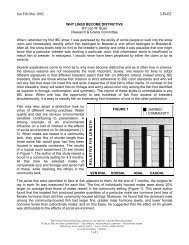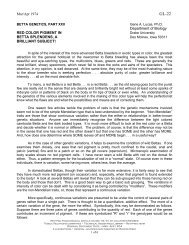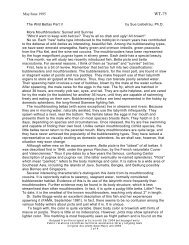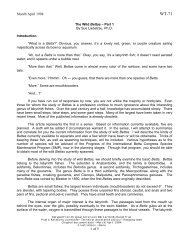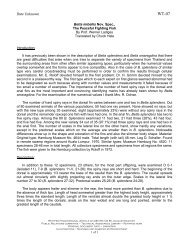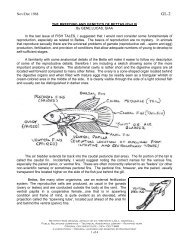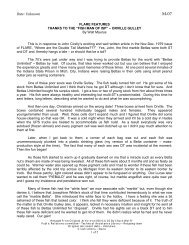CS-11: The Origin of the Marble Betta - International Betta Congress
CS-11: The Origin of the Marble Betta - International Betta Congress
CS-11: The Origin of the Marble Betta - International Betta Congress
You also want an ePaper? Increase the reach of your titles
YUMPU automatically turns print PDFs into web optimized ePapers that Google loves.
Date: Unknown<br />
THE ORIGIN OF THE MARBLE BETTA<br />
Rollie Hansen<br />
<strong>CS</strong>-<strong>11</strong><br />
I think a little ancient history might be <strong>of</strong> help to <strong>Betta</strong> breeders who are currently<br />
working with strains <strong>of</strong> marble <strong>Betta</strong>s. In <strong>the</strong> beginning, <strong>the</strong>re were only what we called "lethal<br />
gene" black <strong>Betta</strong>s. A mating between two black phenotype <strong>Betta</strong>s would result in a nest full <strong>of</strong><br />
fungused eggs. <strong>The</strong> only way to obtain black <strong>Betta</strong>s was to mate a male fish (<strong>the</strong> blackest one<br />
you had) to one his sisters, daughters, or mo<strong>the</strong>r who did not show black. Generally, I selected<br />
<strong>the</strong> female which displayed <strong>the</strong> least amount <strong>of</strong> red and <strong>the</strong> most steel blue. This cut down on<br />
<strong>the</strong> red (which changed <strong>the</strong> fins to a brownish cast) and <strong>the</strong> blue and green iridocytes. In 1969,<br />
my blacks won <strong>the</strong> international using this approach. <strong>The</strong>re was one o<strong>the</strong>r black fish to take a<br />
place that year. It was a bro<strong>the</strong>r to <strong>the</strong> o<strong>the</strong>rs, and was sold by me to <strong>the</strong> owner. That was in<br />
Detroit.<br />
About that time, Walt Maurus was selling a selling a strain <strong>of</strong> fish called "golden<br />
Something or o<strong>the</strong>r," and he supplied <strong>the</strong>se to me. This strain had <strong>the</strong> peculiar habit <strong>of</strong> having a<br />
type <strong>of</strong> pigmentation grow up over its eyes as it aged, and <strong>the</strong> eyes bulged a bit to give it a<br />
goggle-eyed appearance. If that wasn't what we today call <strong>the</strong> "opaque factor", I miss my guess.<br />
<strong>The</strong> crossing <strong>of</strong> <strong>the</strong>se fish with <strong>the</strong> black strain, which I had developed, resulted in <strong>the</strong><br />
standard blacks which were common throughout <strong>the</strong> late 1960's and early 1970's. If <strong>the</strong>y came<br />
from me, <strong>the</strong>y all had <strong>the</strong> opaque factor. At <strong>the</strong> same time, I also had an agreement with Walt.<br />
Many or all <strong>of</strong> <strong>the</strong> black phenotype or genotype fish which he sold were drop shipped out <strong>of</strong> my<br />
fish room.<br />
About that same time, I also had some lousy yellows. <strong>The</strong>y were almost clear white with<br />
blue eyes and were referred to as cellophanes. Anyway, I did cross melano black with <strong>the</strong><br />
opaque factor to <strong>the</strong>se cellophane <strong>Betta</strong>s. This resulted in a very small percentage <strong>of</strong> <strong>the</strong> clear<br />
cream bodied fish with black fins.<br />
I <strong>of</strong>fered <strong>the</strong>se fish in FLARES stock shop as black Cambodians. This terminology was<br />
immediately shot to pieces as a contradiction in terms. Cambodia is <strong>the</strong> reduction <strong>of</strong> black<br />
pigmentation, I was told. Black Cambodians couldn't be, but I had <strong>the</strong>m.<br />
<strong>The</strong> more I look back on those initial breedings, I wonder is I just wasn't lucky enough to<br />
partially eliminate <strong>the</strong> black pigment from <strong>the</strong> body and to concentrate it in <strong>the</strong> fins.<br />
It should be noted that from my earliest work with blacks I was continually eliminating<br />
red. <strong>The</strong>se cream bodied fish with black fins possess greater and lesser amounts <strong>of</strong> black in<br />
<strong>the</strong>ir fins, and occasionally <strong>the</strong>re were flecks <strong>of</strong> black on <strong>the</strong> body. However, <strong>the</strong>re was rarely<br />
any red. I was already toying with <strong>the</strong> term: marble. This is why I objected to Jim Sonnier's<br />
statement that a bit <strong>of</strong> red in marbles was preferred.<br />
Retyped from original article on 01/22/02 by <strong>the</strong> Page Family<br />
Public Relations Committee ~ technical assistance library ~ retyping team<br />
<strong>Origin</strong>al document date ~ Unknown<br />
Illustrations ~ None<br />
1 <strong>of</strong> 1
Date: Unknown<br />
<strong>CS</strong>-<strong>11</strong><br />
Don't overlook <strong>the</strong> fact that this entire lineage was that <strong>of</strong> standard black, also known as<br />
melano, and carried <strong>the</strong> lethal gene. Whenever line breeding was used, you wound up with<br />
fungused eggs. <strong>The</strong>re was a brick wall. You had to take one or two steps backward, as it were,<br />
to go one step forward.<br />
At <strong>the</strong> 1970 IBC convention held in Cincinnati, Ohio, a wonder appeared. It wasn't at <strong>the</strong><br />
show, but in <strong>the</strong> fish room <strong>of</strong> a guy named Jean Roche. I was unable to obtain any <strong>of</strong> <strong>the</strong><br />
particular fish from him, but Gene Lucas did get some. I owe it to Gene Lucas (as we all do) that<br />
fertile blacks were propagated. I don't know who else may have bred <strong>the</strong>m, but I had thousands.<br />
<strong>The</strong>se fish were different from <strong>the</strong> regular standard blacks in that black fish could be<br />
bred to black fish, and by gosh, you got black fish. Usually. Some <strong>of</strong> <strong>the</strong>m were speckled with<br />
black and o<strong>the</strong>rwise were white (fish flesh colored). <strong>The</strong>se I immediately tagged "marble."<br />
O<strong>the</strong>rs had a greater amount <strong>of</strong> black on <strong>the</strong> body and fins but had white heads, and I named<br />
<strong>the</strong>m "piebald." I swear to this day that until those fish put in an appearance, I had never heard<br />
<strong>the</strong> terms marble or piebald applied to <strong>Betta</strong>s.<br />
Now ano<strong>the</strong>r thing happened. At <strong>the</strong> auction <strong>of</strong> ano<strong>the</strong>r IBC international convention, I<br />
purchased <strong>the</strong> only fish I have ever bought at an auction. It was a male Indonesian fish with<br />
green and yellow fins. It also had a very unique feature- a double caudal. Gene Lucas allowed<br />
me to out bid him on this fish in <strong>the</strong> way that Gene is able to do. I blew a whole five-dollar bill on<br />
<strong>the</strong> first non-red double tail male <strong>Betta</strong> this country had ever seen. Gene knew immediately what<br />
it was, and he let me have it. I owe Gene Lucas many things, and this is one <strong>of</strong> <strong>the</strong>m. (Although<br />
I'll never forgive him for requesting red <strong>Betta</strong>s that were really red, and me sending <strong>the</strong>m to him<br />
by <strong>the</strong> dozen only to find out years later that he was boiling <strong>the</strong>m to get red pigment.)<br />
Now I had ano<strong>the</strong>r cornerstone. Not wasting time, that non-red, green doubletail was<br />
bred to <strong>the</strong> fertile black strain. It began to save a lot <strong>of</strong> time when your first mating produced<br />
what you wanted in plain view. I got doubletailed blacks and doubletailed whites within two<br />
generations, and <strong>the</strong>n it was just a matter <strong>of</strong> cleaning <strong>the</strong>m up <strong>of</strong> iridocytes. <strong>The</strong>re never was<br />
any red, and if <strong>the</strong>re was, it was eliminated by <strong>the</strong> non-red gene with <strong>the</strong> doubletailed<br />
Indonesian obviously displayed.<br />
Now let's go back to several questions that have recently popped up. To differentiate<br />
between a black lace <strong>Betta</strong> and a melano black with <strong>the</strong> opaque factor, we look at <strong>the</strong>m. That<br />
will probably not satisfy you, but that is all you would need to do.<br />
<strong>The</strong> standard black which carried <strong>the</strong> lethal gene did not have any <strong>of</strong> <strong>the</strong> lacy<br />
appearance <strong>of</strong> <strong>the</strong> later fertile black which, on <strong>the</strong> o<strong>the</strong>r hand, almost always displayed that<br />
characteristic. <strong>The</strong> black <strong>of</strong> <strong>the</strong> standard black was usually an even gradation <strong>of</strong> <strong>the</strong> black<br />
coloration. <strong>The</strong> fertile black seemed to have rectangular specks <strong>of</strong> black on clearer fin material.<br />
Basically, <strong>the</strong> standard black was smoked evenly, and <strong>the</strong> fertile black had a lace-like<br />
appearance.<br />
Retyped from original article on 01/22/02 by <strong>the</strong> Page Family<br />
Public Relations Committee ~ technical assistance library ~ retyping team<br />
<strong>Origin</strong>al document date ~ Unknown<br />
Illustrations ~ None<br />
2 <strong>of</strong> 2
Date: Unknown<br />
<strong>CS</strong>-<strong>11</strong><br />
<strong>The</strong> two types can also be differentiated by spawning <strong>the</strong>m. Since standard black carried<br />
<strong>the</strong> lethal gene as well as <strong>the</strong> opaque factor, <strong>the</strong>n only <strong>the</strong> black lace <strong>Betta</strong> will reproduce<br />
phenotype to phenotype.<br />
This brings us to <strong>the</strong> question <strong>of</strong> spawning marbles. As you have seen, <strong>the</strong>re are two<br />
types <strong>of</strong> marbles, if by this time one or <strong>the</strong> o<strong>the</strong>r hasn't been completely screwed up. One is<br />
from standard black, and <strong>the</strong> o<strong>the</strong>r is from <strong>the</strong> fertile black. <strong>The</strong> fertile blacks are <strong>the</strong> easiest to<br />
work with since a mating <strong>of</strong> a black appearing female to a black appearing male will produce<br />
eggs that hatch. <strong>The</strong> <strong>of</strong>fspring will be black (all black), black and white (marbles) white and<br />
black (still marbles), and a very few all white (cellophanes). A very few <strong>of</strong> those which are black<br />
and white or white and black will have a white head and a great deal <strong>of</strong> black on <strong>the</strong> body, and<br />
although <strong>the</strong>y are known as piebalds, <strong>the</strong>y are only a color variation.<br />
If you have fish derived from fertile black to a standard black, you have problems<br />
because <strong>the</strong> lethal gene has been bred into both <strong>of</strong> your fish, male and female, and a black<br />
appearing male mated to a black appearing female will not produce viable eggs. You will now<br />
have to mate a black male to one <strong>of</strong> his sisters, daughters, or mo<strong>the</strong>r which does not look blacka<br />
black genotype. This brings you back to breeding <strong>the</strong>m like standard blacks.<br />
Now we are down to <strong>the</strong> possibility that your fish come from purebred standard blacks<br />
and your batch <strong>of</strong> fry comes from a black male which was mated to a direct lineage female<br />
which was <strong>of</strong> any o<strong>the</strong>r appearance but black (and if you got <strong>the</strong> tip earlier that a dark sister with<br />
<strong>the</strong> least red and ei<strong>the</strong>r steel blue or opaque in appearance ra<strong>the</strong>r than green or blue) hang on.<br />
<strong>The</strong> black color is not <strong>the</strong>re in <strong>the</strong> first few weeks, but begins to develop generally after six to<br />
eight weeks.<br />
In conclusion, <strong>the</strong> manner in which you propagate marbles depends on what line you are<br />
working and how pure it is. It may or may not take two generations. If you're working with pure<br />
fertile, you get <strong>the</strong>m on <strong>the</strong> first try. If you didn't, <strong>the</strong>n you will have to use <strong>the</strong> blackest male with<br />
<strong>the</strong> best looking female from <strong>the</strong> hatch which is not black in appearance.<br />
I've had a lot <strong>of</strong> fun reminiscing through ancient and medieval history. It has brought<br />
back many pleasant memories which I hope will help many <strong>of</strong> you to better understand marbles.<br />
Retyped from original article on 01/22/02 by <strong>the</strong> Page Family<br />
Public Relations Committee ~ technical assistance library ~ retyping team<br />
<strong>Origin</strong>al document date ~ Unknown<br />
Illustrations ~ None<br />
3 <strong>of</strong> 3




